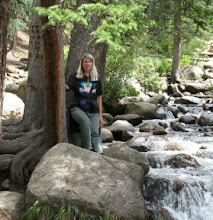This is, perhaps, what you get when you operate a permeable, and somewhat flexible, household. I'm more than willing, most of the time, to live and let live. If you're squeamish about things with lots of legs, you might want to move on to another post. A picture is coming around the corner.
Saturday I pulled a can of corn from the pantry, only to find a bug on it. "Harlequin" popped into my mind, but most I find online are shaped the same but colored somewhat differently. It looked most like this one, so perhaps I'm on the right track. It too went to a nearby house plant; one not in the cabbage family (just in case).
Most of my household spiders are nondescript little guys, and I rarely have time for identification while in the process of "rescue." Next up, however, is one I did recognize.
 This one came in from the cold on her own, almost. That is, it's hard for me to ignore a critter that is virtually knocking on my back door. Cold weather and certain death ahead, I, um, brought her inside for the winter. Isn't she cute? I figure a couple crickets from the pet store will keep her happy til spring.
This one came in from the cold on her own, almost. That is, it's hard for me to ignore a critter that is virtually knocking on my back door. Cold weather and certain death ahead, I, um, brought her inside for the winter. Isn't she cute? I figure a couple crickets from the pet store will keep her happy til spring.What would you have done?
The Black Widow, unfortunately, is the most visible of Colorado's two venomous spiders and is often killed on sight. Patent-leather black, with her distinctive hourglass, she could hardly be a more elegant house guest, if a bit sinister in her jerky movements. (Any fuzziness is the photo, not her.) Having set up housekeeping in a mason jar, she dangled conveniently upside down on her web when I checked in this a.m. Black widow webs lack the symmetrical beauty we appreciate from the orb weavers; they are instead a tangled mishmash of very strong threads. Their venom is strong, about 15 times that of a prairie rattlesnake, but they inject only a tiny amount, so they are less deadly overall. I hope not to bring you a personal report on that experience.
When I lived in Arizona, a fellow grad student once kept a widow, along with her egg sac, in a similar mason jar. A few small airholes in the lid are, of course, important. Unfortunately, though she stayed safely in the jar, her tiny hatchlings had no qualms about using the escape routes!
Right after I took this picture, I was watering houseplants. Pulled a little variegated Hoya down and discovered a sizable web on it. By the time I got it watered, I'd dislodged a medium-sized spider and managed to drop the plant (with its extra water) on the floor. First priority, though, was to catch the spider. (Don't worry, she's fine; safely back in her home, though it now needs some renovation.)
This winter's not the first time we've had spiders in the house. For more on making critters welcome, see Not So Good Housekeeping, over on Small Wonders.
Let's face it: we rarely get to see timber wolves or grizzly bears. Instead, charismatic microfauna such as these are the small wonders with which we live most intimately. These are nature's representatives we are most likely to see most often. If we can't appreciate—and tolerate—them, can we truly call ourselves nature lovers?





















